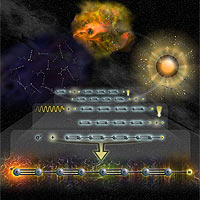To build and develop career www.careerbd.net
perfume presents personality www.perfumeplus.zlio.com
Step into a forest in southern Ontario and a dizzying array of diversity pummels the senses: ferns line a stream, songbirds flit overhead, lichen pepper a tree stump, a mosquito finds the soft flesh on your arm.
Unless you have a degree in taxonomy, identifying all of the flora and fauna is an insurmountable task.
University of Guelph scientists hope to change that using something retail stores have relied on for years: bar codes. Researchers at the Biodiversity Institute of Ontario are starting to assign a unique DNA identifier in the form of a genetic bar code to every animal species on the planet.
They are not alone in their quest. Since the idea was first published in 2003 by University of Guelph professor Paul Hebert, DNA bar coding has been adopted by 160 organizations in 50 countries and more than 31,000 species have been coded.
Experts believe it has a host of applications, from catching agricultural pests at the border to quickly identifying disease-carrying mosquitos.
It will help researchers discover species and trace evolutionary patterns, says David Schindel, executive secretary of the Consortium for the Barcode of Life, at the Smithsonian Institution in Washington, D.C. and host of next week's second international Barcode of Life conference in Taipei.
Scientists are bar-coding as many species as possible in an effort to create a global reference library, says Schindel.
Much like a fingerprint database, DNA bar-coding only works if there is a comprehensive catalogue from which to compare samples.
Barcoding will soon allow scientists to quickly identify hard-to-distinguish species within hours, rather than days. Taxonomists usually use physical characteristics, such as colour markings, to classify an animal. But that won't always work; scientists may only have a small piece of an organism to work with.
When dead birds carrying avian flu washed up on the shores of Scotland, it took weeks to identify the species as swans because they were so decomposed, Schindel says.
"If we could have bar-coded the species, we would have known what they were within a day and, possibly, where they came from," he says. "It would have been a big help for public health officials."
Hebert, who holds a Canada Research Chair in molecular biology, had long thought DNA could be used to identify species.
Scanning an animal's entire genome would cost too much and take too long, so he pinpointed a short piece of DNA - a section of a gene called cytochrome c oxidase 1, or CO1 - that could distinguish one animal from an other. It was a successful hunch, though it can't be used for plants.
"The results of the first wave of studies have been so positive that the plan to bar code all life is simply irresistible," Hebert wrote in an email while travelling in Korea.
He believes 500,000 animal species will be bar-coded within five years.
The Biodiversity Institute of Ontario, which opened in May, houses the world's leading DNA bar-code facility. Robert Hanner, an assistant professor at the University of Guelph and co-ordinator of the Fish Barcode of Life Campaign, says the lab is able to code between 12,000 and 20,000 samples a month, for $2 a sample.
Agricultural groups have approached them to bar-code insects that affect Ontario crops, he says.
Critics say DNA bar-coding isn't nearly as accurate as promised.
Felix Sperling, a biology professor at the University of Alberta, points out bar coding seems to work best for identifying species, such as birds, that are easy to distinguish by physical characteristics.
It does not work as well for other plant and animal groups, such as lichen, fungi and parasitic insects, he adds.
That doesn't bother Spencer Barrett, a University of Toronto professor of evolutionary biology, who is looking for a piece of DNA that can be used to distinguish plant species.
"The next big frontier, the next big scientific question, is to identify all of the biodiversity on Earth," he says, noting only 1.7 million species have been named of some 20 million to 30 million species.
HOW IT WORKS
Scientists only need DNA from a single gene to identify most species of animals on Earth.
• First, a tissue sample is collected and sent to a lab, where DNA can be extracted.
• The target piece of DNA - a portion of a gene called cytochrome c oxidase 1 (CO1) - is copied many times, using a technique called polymerase chain reaction.
• The copies are sequenced to determine the exact order of the four base pairs (A,T,C,G) within the strand of DNA, which generates the specific barcode for that species.
• The barcode information, along with the animal's taxonomic name, photos, GPS co-ordinates of where it was found, and other distinguishing characteristics, are entered into the Barcode of Life data system. It's accessible to anyone at www.barcodinglife.org.
PROMISING APPLICATIONS
• Quickly identifying species of mosquitos that carry diseases, including those that carry West Nile virus or malaria.
• Checking for consumer products made from endangered plants or animals.
• Identifying invasive insect pests on agricultural shipments going in and out of Canada
• Environmental monitoring - mapping how birds shift breeding territories in response to global warming, for example.
• Tracing unwanted plant and animal ingredients in foods.



